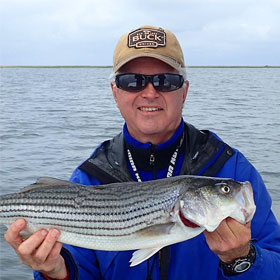How to Catch Salmon Ice Fishing
By Ken Schultz
Feb 10, 2021
Here’s what you need to know about how to catch salmon ice fishing, when Kokanee salmon and landlocked Atlantic salmon are the species being targeted
Of the various salmon species, the ones for which there is a viable through-the-ice angling option are those that are landlocked, meaning that they live their entire lives in a lake environment and do not migrate elsewhere. This includes the Kokanee, a mostly northwestern dweller which is the landlocked form of sockeye salmon, and the landlocked Atlantic salmon, a mostly northeastern dweller which is often simply referred to regionally as a “landlocked salmon” or “landlock.”
Ice fishing for salmon is not unlike ice fishing for trout, at least in the case of landlocked Atlantic salmon, and there can be overlap of species landed in some bodies of water. Lake trout, in particular, may be caught while ice fishing for landlocked salmon. There are similarities as well as differences in how to fish for both salmon species. Here are some things to consider about how to catch salmon ice fishing:
Expect a challenge
To learn how to catch salmon ice fishing with some degree of regularity you have to understand that these fish live in generally large and deep bodies of water; roam widely, usually in schools; can be hard to locate; and may not be abundant.
Think deep and deeper
Most of the time you’ll want to be ice fishing for salmon at least 15 feet below the surface (and perhaps down to 80 feet). Where you can use multiple rigs or tipups, set up to cover a broad expanse where the depth of the bottom is sloping downward.
Use sonar
Using sonar to locate salmon or baitfish is a big help in knowing what depth to fish. Look for dropoffs and places that could funnel bait.
Vary your depth
If using tipups with bait for landlocked salmon, place the bait at different depths until you have success. Then adjust the other rigs up or down so they are at the same level of the tipup that produced.
Live bait is good for landlocks
Using whatever baitfish is preferred by landlocked salmon in the lake you’re fishing is always desirable. In many landlocked salmon waters that’s smelt, but they are hard to keep alive. Hardier shiners may be better, especially if they’re similar in size to what the salmon normally eat.
Lures are good for Kokanee
Kokanee are plankton feeders. Since they don’t eat smaller fish, there’s no need for live bait, although they may be caught on salmon eggs and hooks or lures tipped with mealworms, corn, or some form of processed bait. They are also curious. Small colorful spoons are useful, and some anglers jig using small flashers without hooks as attractors, connected to a leader and a fly or baited hook.
Don’t forget your fishing license when you go, happy fishing!









